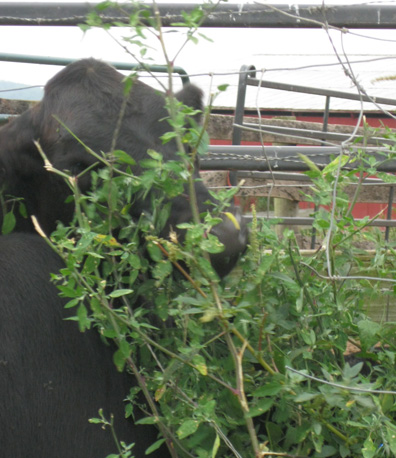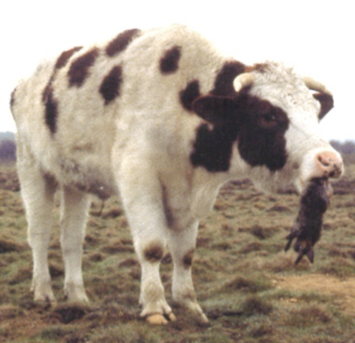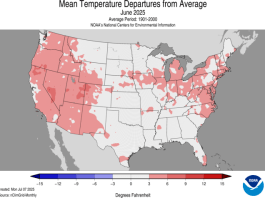
Sometimes our trainees are doing just what they’re supposed to. It’s our assumptions that make us think things aren’t going quite right. I’m reminded of this every year when I get calls form farmers and ranchers who are in the process of teaching their cattle or sheep to eat a new food. Everyone, including me, has an idea in their heads that after going through the training process, when we put out the tubs with weeds in them, the cows will eat everything in the tub. But that never happens, not because the trainees aren’t learning, but because they’re doing exactly what an animal does when it learns. They try just a bit, wait to see what the internal feedback mechanism says about the new food, and THEN decide to eat more.
Here’s an example: Chuck Talbott, the Ag Agent for Putnam County, West Virginia, wrote me in early August of 2011 about a training demonstration he put on. He’d gone through the whole training process with 13 replacement heifers. During the training the heifers would eat their snack and then head back to pasture to eat things he didn’t expect them to eat like lambsquarters, pre-bloom curly and smooth dock, and spiny pig weed. The pig weed was actually the target weed for this demonstration.
Everything was going well until the day he was to introduce the weeds.Since this was a demonstration, Chuck invited folks to watch the heifers on the very first day of trying spiny pigweed in the tubs. Everyone was disappointed when the heifers nosed around in the tubs a bit, ate some of the supplement, but left the cut weeds, and then went back to pasture to eat…weeds!
The next day, Chuck and I talked on the phone. ”Everything’s just fine,” I told him. ”Your heifers did pretty much what all my trainees have ever done.” Based on our conversations we made a few other adjustments. He switched from pigweed, which was seeded out and not as nutritious, to ironweed, and hist trainees ate 80% of that plant on its first offering.
I’ve also been talking to a rancher in Arkansas who is teaching his cattle to eat musk thistle. When he called, he said that he had one cow that had eaten some, but he was concerned that he didn’t see all of them eating it. They just walked away, but they did come back and finish it later. I’ve seen this so many times, that to me, this is normal, but I’ve had that same anxious thought as this rancher had, “I did all that training, and now they’re not going to eat weeds.” I explained to him that he just needed to give them a little time, and they would get better and better at eating weeds.
I also told him what I tell everyone: spend some time in the evening in pasture with your trainees. I usually sit down in or near a patch of the target weeds to watch them. Because the training has made them accustomed to me, the come over to check out what I’m doing, and to see if I’m bringing them any food. When I just sit there, they get bored and start grazing on whatever is near by. And since I’m sitting in the weeds, that’s what they begin to eat. That’s how I get all those good pictures of cows eating weeds for my videos.
We all have assumptions. It’s hard to live without them. But once we recognize them, we can see what’s really happening and feel better. To help you adjust your assumptions, here’s a video showing what cows normally do when they’re trying a new weed.
One more assumption breaker I have to give you is based on an assumption I created for you. Lots of my videos show cows running to the training tubs. This is because I’ve watched my audience as they watch my videos and seeing running cows makes them laugh, and when they laugh I feel good. So I’ve included lots of video of cows running to their tubs. I didn’t know this was a problem until working with folks in Oregon. They were kind of depressed and thought they were doing something wrong because their cows didn’t run to the training tubs.
The truth is not all cows run to their tubs. Here’s a video that shows a little of both, slow to help you adjust your expectations, and fast because it makes you laugh.
For more on how you can help your cattle learn to eat this and other weeds, check out the article “How to Teach Livestock to Eat Weeds” or visit Kathy’s website (www.livestockforlandscapes.com) where you can get a Book, DVDs, or a purchase a Coaching Program.




